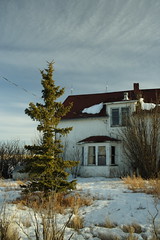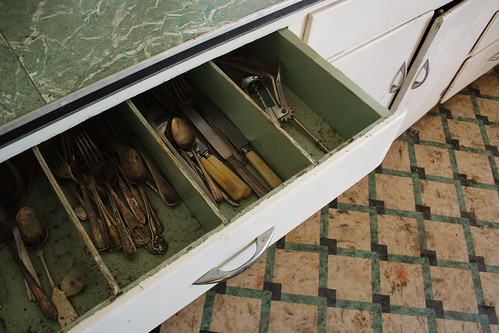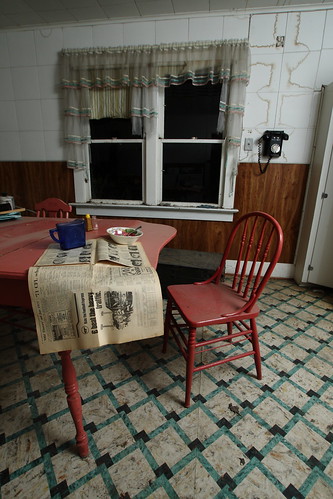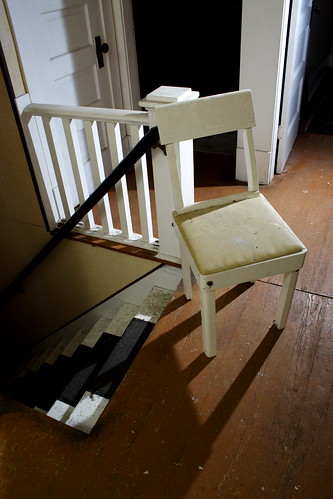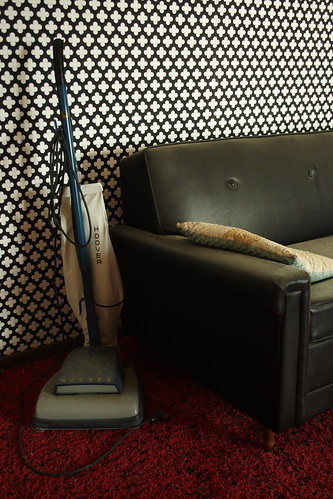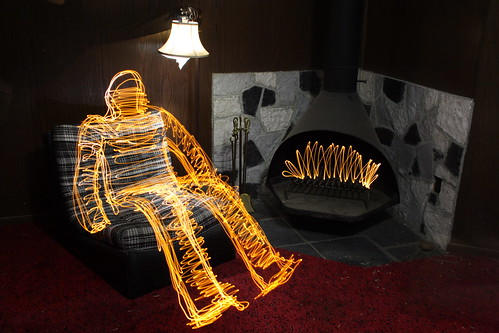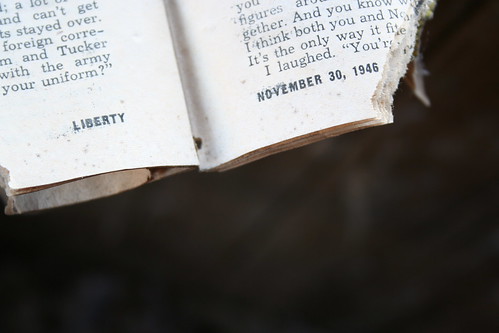Friday, August 14, 2009
The Un-touched House
I was flying from Linden to Drumheller Alberta, practicing some impromptu navigation. A friend of mine was on board for the flight, as I was getting re-accustomed to flying the Cessna 172. It had been a while since I did a navigation flight and it was nice to get out for a simple, quick flight over the countryside. 500’ above the ground, we cruised en-route, turning occasionally to avoid flying directly over farms. It was early spring, and the fields were all brown and had patches of snow covering them still. Coming nearer to the Drumheller airport, I spotted a small farm property below us. I did a quick sharp turn and circled the property to get a better look. The house had a patchy roof and the driveway was overgrown. Abandoned! We continued on to Drumheller and landed there. We then departed again and flew back home.
A few days went by and I called up my friend to see if he wanted to check out the house with me. He agreed and we headed out. The drive was nice, but I had to take a particularly less efficient route to find it because the landmarks were far and few between. I still can’t find the place by simply trying to drive straight to it on the back roads.
The house looked typical from the outside. Paint was peeling off on the outside and there was an abundance of tall grass and ratty looking trees. I parked the car behind the house so we were relatively out of sight. The door to the place was un-locked, but was still hard to open because it would jam tight against the warped floor. Squeezing through the partially opened door, we made our way inside and that’s where our jaws dropped. The house was so completely in tact we were second-guessing it being abandoned.
There were newspapers on the table, pots on the stove, cutlery in the drawers, plates in the cupboards and even liquor in the taller cabinets. The bathroom had a really old box of toothpaste still sitting by the sink, un-opened. The living room had some beautiful leather furniture and a nice fireplace… all complete with shag carpet! Upstairs was where the place was really starting to decay. The two rooms were ok, with some stains from water damage, but the one particular room had patches of the roof plaster falling in and extensive water damage around the roof and walls.
I have never found a place more complete and un-disturbed. It was almost like stepping into another time. You could easily lose yourself there, spending hours looking at all the cool old stuff and flipping through all the papers and sports magazines. I have made several trips to this place since the first visit and I always seem to find something cool to photograph. Its places like this that remind me to never assume that a house will contain nothing new and out of the ordinary. Yes, many houses are the same, but you never know what you could be missing by simply passing by.
Wednesday, July 29, 2009
The Roundhouse

"I looked at you with curiosity, imagining the un-tapped potential you contained. Coming eye to eye, you looked beat. Your days of glory long past. Your tough exterior now erodes, revealing your soft side. Your long history now appears as well respected as the ‘Grad 2000’ graffiti that blemishes your walls. What man has made is now mocked by its creator as well as nature. But don’t worry, you were never meant to exist. See how the land struggles to re-claim you. The wind beats your walls to the earth where grass and weeds await to swallow you. So now you struggle to stand, awaiting collapse. Still, don’t be ashamed in your weakness. There is great beauty in this battle between you and nature. I am glad I had the pleasure of meeting you before you meet your demise..."
~Taken from my original photo description.
It was a late fall day and I was flying from Three Hills to Brooks and then to Hanna with a friend of mine when I first spotted this place. We were taking off west-bound from Hanna, when I noticed a crazy looking old structure just to the left of the track we were flying.
It was a roundhouse, a railway engine service and storage building probably from the 20's-40's. The structure curves around a rotating track called a turnpike, which rotated engines and pointed them toward the desired service bay.
I drove to the building about a week after the flight and took some daytime shots. The drive out there was long and boring and the town wasn't exactly a sight for sore eyes. Many buildings were badly weathered and neglected, which is sometimes cool because it makes for easy photo subjects, but it was also kind of depressing because it seemed like no-one cared about the town's appearance at all. Half the buildings on main street were either for sale/rent or closed till further notice.
The first time I went to the roundhouse at night was to do some evening shots when I was first experimenting with light-painting. The result was a photograph that is still one of my favourite photos of all time (the first picture in this article). It took nearly an hour to get it the way I wanted.
The town of Hanna is as redneck as they come. At 3:00 am, I was still in the building photographing and all through that time I could hear people within the town driving loud trucks, yelling and smashing beer bottles. One day while photographing here, I walked back to my car to notice some teenagers parked nearby on the back of their truck drinking beer. Hanna is also the hometown of Nickelback's Chad Kroeger. The roundhouse itself can be seen in their music video, Photograph:
Sorry for the lame advertisement... or if you don't like Nickelback either.
I was told by a local that the only time that Nickelback has ever made an official visit to Hanna was merely for this nostalgic video.
The roundhouse itself is a wonder to look at. The entire structure is made of wood and brick. The east end of the building has collapsed to the floor, but the rest of it is still standing, barely. Walking through the building for the first time I kept lifting my head upwards, completely amazed by the wooden roof and hanging lights. The building was definitely old and has seen many years of hard work.
The inside was mostly gutted of anything that gave reference to the original purpose of the building. The back of it was made into some sort of auditorium and some offices, a kitchen and bathrooms appeared to be added on or renovated later in it's life. Looking downwards, the building is quite pathetic, with a standard cement floor and some walls. There's a few abandoned vehicles inside that are nice, although most are completely covered in pigeon crap. The real beauty of this building is the roof and upper windows in the service bays. I have never been inside a building with cooler windows and rafters yet.
Outside, the grass is tall and there are a few trees around the building. In the fall and early spring, the golden colors give this building a gorgeous contrast and makes for some incredible photos. The old truck seen in the lower photo has apparently been moved. A friend of mine went down to Hanna a short time ago and said it was gone.
My recommendation to anyone curious and wanting to check this place out is to bring some good boots (there's nails everywhere), a dust mask (mould and pigeon poo) and a couple cans of beer in case you need to appease the locals. Oh yeah, and try your best to visit some shops in town and spend a little... they could use the boost.



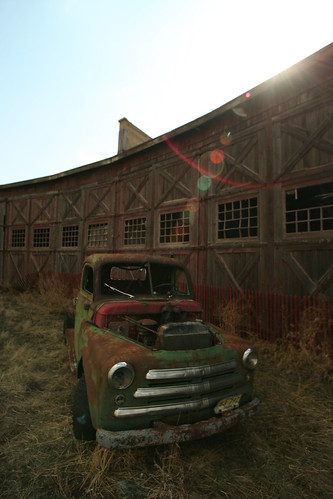
Monday, July 13, 2009
The Greenhill Mines

Located in the Crowsnest Pass, the Greenhill mine is a place that first grabbed my attention several years ago when I was passing by on a motorcycle trip. The giant tipple is visible from the highway and stands proudly, overlooking the town of Blairmore.
The Greenhill Mine was first opened for operation in 1913, and had peak production in 1946, employing 500-600 men. The mine closed in 1958.
While on a large exploration trip with my friends Bobby and Jeremy, we stopped here on the second day. It was a simple entry with only one fence to hop. The structure was solid steel and concrete with the beginning sections made of wood, that had now partially collapsed. Walking through the rafters of the collapsed roof, we made our way inside the tipple. The inside was amazing with thus far, the coolest coal car track system I have ever seen. It was one of those buildings that you had to first explore and then later take the camera through because it was too exciting to just simply begin photographing. It was the kind of place that you walk through and can't help but imagine what it was like in its heyday.
The top level had a main track leading into a car tipper, which inverted the coal cars one at a time and dumped the coal below, where it would be sorted and processed. After the car was empty, it was ejected from the tipper and rolled down a slope either to the left of right, up and down a return ramp, and then to a towing conveyor that pulled the cart back to the top again so it could be returned to the mine.
The structure was quite old and already had many signs of decay. You had to be careful walking around on the wooden boards near the beginning and sides of the structure. Much of the wood was rotting. On my second visit to the structure I saw an owl take flight after noticing me. The most startling thing about the owl flying away was that where it was perched, the parallel wooden railway supports, were crumbling merely from the owl taking flight. Not exactly the best place to climb for that 'perfect shot.'
The giant tipple had enough goodies inside it to keep a photographer busy for hours, but the rest of the property also had its share of fascinating buildings. The old shower house was also a storage building for core samples. Literally tons of core samples were all staked on top of each other, filling a room about the size of a community hall. The building was cold, moist and had water dripping from its roof and running in small rivers around the rows and rows of stacked core sample boxes. Beautiful. The building was unlike any place I have been before. It was interesting to be inside a dead-still building with nothing but tiny creeks of water dripping and flowing. It seemed a prime example of something I have grown to learn with each adventure. Over time, nature always wins. The persistence of wind, water and sun can bring any building to its knees.
Walking around the property, there were random small buildings everywhere. A lot of them had great signs of vandalism and many were so scrapped and destroyed that they were neither recognizable in purpose, or worthy of a picture. I would have to say the buildings most worth seeing are the tipple, the wash house and the mine entrances. Exploring any of the other buildings went something like this... "What's in there? (peek inside) ...Huh. (leave)." Of course there were a few slight exceptions, as some of the buildings had hidden gems.
The mine entrances had covered roofs that ran about 1000' along where the coal car tracks used to go in and out. The roof had hundreds of holes through it that almost felt like a disco when you walked through, because of the sunlight spilling into each hole and casting tiny dots of light over your body. The floor inside the entrance shelters had a small creek flowing through it that's source was the mine entrance. Water seemed to be a persistent theme in most of the buildings.
The Greenhill mine is a site that I wouldn't consider 'risky' to explore. It obviously had it's physical risks like collapsed roofs and exposed sharp things, but no-one seemed to care that we were there. A curious photographer once approached the main building while we were inside, getting some exterior pictures but not entering. There were also some teenagers shooting off pellet guns near the mine entrance, who quickly packed up and left as we came by. Aside from that, nothing gave us the notion of consequence for being there. Signs warning against trespassing were broken or paintballed and the drive up to the site was extremely worn from people being there.
A pair of steel-toed boots, a camera and a friendly smile will keep you safe from almost every hazard you should encounter... ...unless you're afraid of getting dirty ...and abandoned places ...and owls.
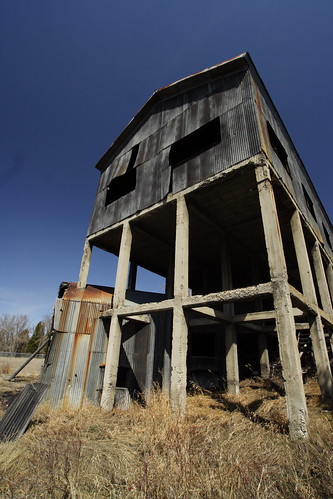
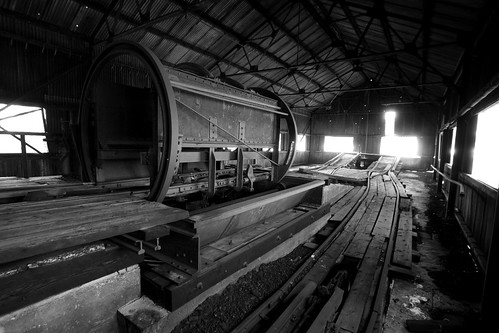
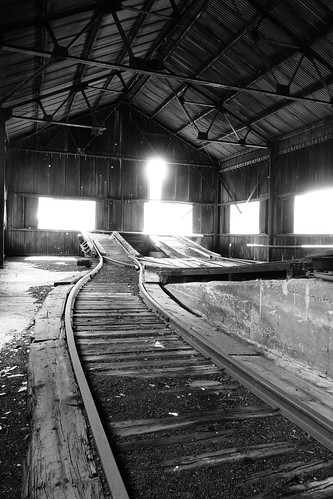

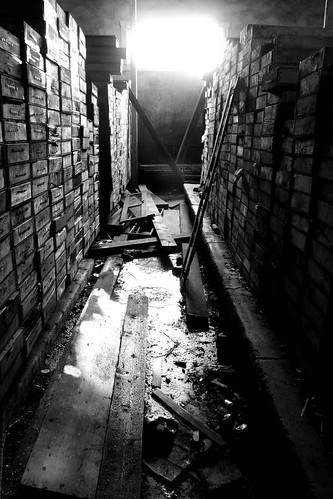
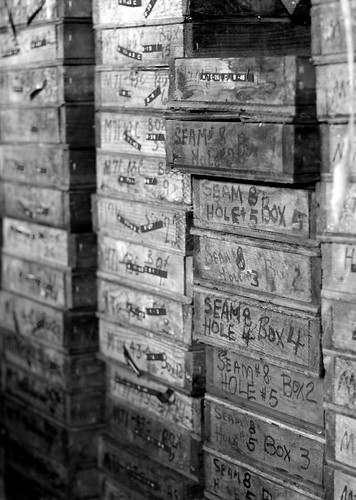
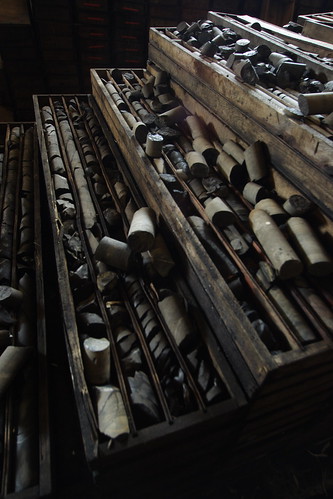
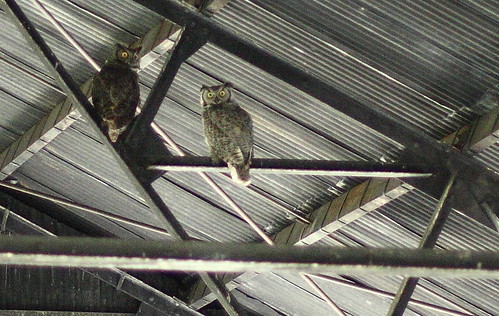
Labels:
Abandoned,
Adventure,
Crowsnest Pass,
Decay,
Derelict,
FuriousD,
Historical,
History,
Mine,
Urban Exploration
Wednesday, July 8, 2009
The Graveyards
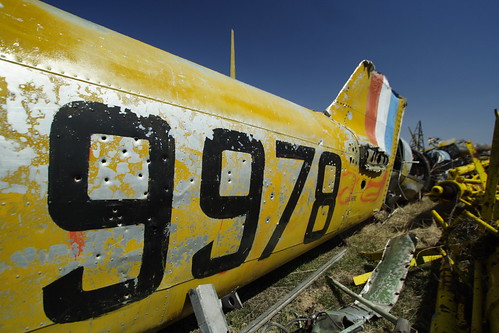
This is actually a collection of four different locations in one. All of which contain abandoned training bombers (Avro Ansons from WW2) and some other various aircraft of the same vintage. In Southern Alberta there were numerous WW2 training bases for the RCAF that are almost all abandoned or turned into publicly registered aerodromes (Innisfail, Lethbridge... etc.).
The first two aircraft locations I owe great thanks to my friend Bobby for finding. Without him, I probably wouldn't have even imagined that these amazing aircraft were left strewn about. The first aircraft I explored was the first one that Bobby found and told me about. I drove almost 4 hours just to see it, and I even ended up driving around aimlessly for about an hour extra while on the phone with Bobby because we were trying to figure out which range road the farm was on exactly. He knew the location visually more or less, so he didn't remember the exact road numbers.
After some re-traced steps and one huge sigh of relief, I found it. The location was an old farm with piles of junk strewn about surrounded by a fence and signs saying 'No Trespassing' and 'Beware of Dog.' I parked as best as I could so as to not be seen and hopped the fence. I made my trip very brief; in and out. The aircraft blew my mind and I was super glad to have seen it.
Bobby got my attention a second time when he posted yet another abandoned airplane. I humbly begged him to tell me where it was so I could check it out. Again, I made a trip down there to see this second aircraft. This second trip wasn't near as productive as the first, because it was during a crazy cold winter and the winds were torture. I was only there for about 20 minutes and the I had to leave and warm up.
Trip number three was again to the second plane. I was heading down to the Crowsnest Pass and wanted to make a second attempt at the other bomber since it was finally warm out. While photographing it one of the property owner's, a really nice lady, explained to me that the bomber actually belonged to the Nanton Lancaster Museum and that it was being stored at their place until they could find something to do with it. She also invited me to fly to their place at any time and land at their private airstrip!
The coolest thing she told me after that was that she knew of a scrap-yard also owned by the museum where there were many, many more bombers all bunched together. With the new directions I headed on my way.
This third aircraft location was mind-blowing. Not only was there about 30 WW2 vintage bombers all scrapped and abandoned, but there were old cars and an abandoned house quite unusual in shape and design. The lady called it the 'Cancer House, because it looked like a bunch of tumour growths.
I spent nearly two hours exploring and photographing the planes and other cool machinery and then headed down the road again. On my way South, I passed through the small town of Nanton, where I stumbled across location #4. Just near the edge of Nanton is a small collection of Avro Anson parts and an old Beech 18.
I could not believe how many of these planes were abandoned. I guess looking back on it now, it totally makes sense. There were dozens of training bases and none of those planes actually saw combat, so they had to end up somewhere. Here in Southern Alberta is this large chunk of history that has been preserved through some aircraft and photos and museums, but in majority sits lost and exposed to the elements. It would cost far too much to preserve them all and so for myself, seeing the collections hidden in random locations has finally given me a true image of just how large the training operations were. It was one thing to see a plane in the museum, but it was quite different to walk through dozens of them neglected and essentially, left to die.
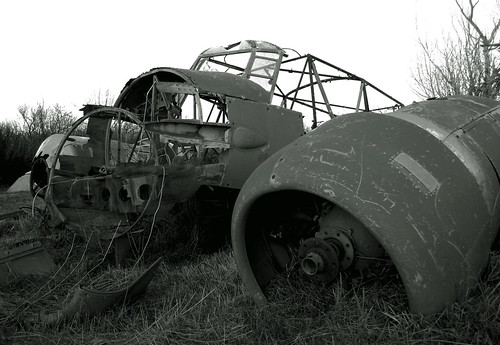
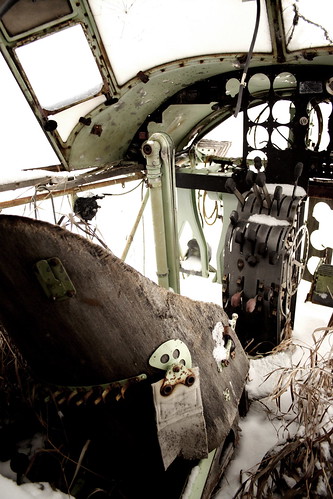
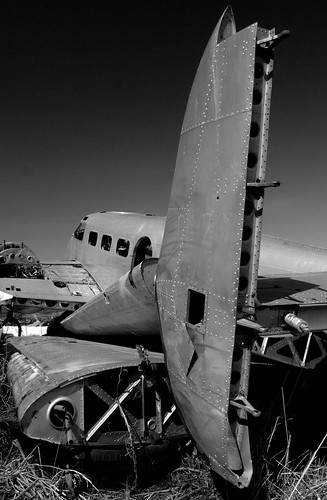
Tuesday, July 7, 2009
The Mowhawk Tipple

Located just off the Crowsnest Highway in Southern Alberta is this beautiful structure. It doesn't look all that tall from the road (about two stories or so..), but it's actually huge. Standing on the lowest level, it appears to be about 8 stories tall (what's left of it) and is now little more than a massive concrete skeleton built into the side of a hill.
My first experience exploring this place was when I had planned a road trip with two other photographer friends (Jeremy and Bobby) in the beginning of April, 09. I had seen the structure long ago and numerous times and had always been curious about it. It always emerged ominously as I was driving by and my eyes would wander dangerously from the road to fixate on it.
One day I was reminded of that building (don't remember even how) and I started doing some Google searching to see what it was exactly. I now know it as the Mowhawk Tipple, part of the old Hillcrest Mine.
I contacted my friends to invite them along, and it turns out Jeremy's parents actually live in nearby Coleman. We had somewhere to crash! We headed out early on a Friday and began exploring stuff and photographing on our own. I was the first to make it to the tipple at around supper time. I had been exploring a previous location that morning which I'll post at a later time (it's a good-er).
The building was sketchy, at best, with nothing inside it except a few, mostly wobbly, steel walkways with no handrails and some crumbling brickwork. It didn't really matter to me that the building was pretty much gutted, because that was part of what made it so beautiful. It was a towering ruin; a limping testament to a dying industry. Walking around inside the building, it almost felt as though the whole thing would crumble at so much as a fart... but I still had to explore every nook and cranny. It wasn't long before I had gained faith in the building and it started to feel solid. The sketchy steel walkways didn't help, but still knowing that the structure has survived countless storms, winters and the ever present winds of insanity that go whipping through the Crowsnest pass all the time gave me confidence that my careful steps would do no harm.
I went through the building for about two hours alone and scaled the steep hill, clutching my camera equipment the whole way. There was so much to look at, and a pile of night photography ideas whipping through my head. I left the location with several shots in the memory card. My next stop was to get some food. I hadn't eaten anything in about 10 hours! Mmm... Subway.
I got a call from Jeremy and we met at Subway. After a quick bite, we headed to his parent's house to drop off some of our junk and then we headed out again to the tipple for some night shots. Jeremy was really excited about the building because he had always seen when he was younger, but this was the first time actually going inside it.
Night photography is ALWAYS more dangerous than during the day! I felt a few moments of panic walking along the steel steps and catwalks, but luckily didn't fall or drop any equipment. We took a few shots that night, but only a few were keepers. We went to bed at around 2:00am, and headed out again the following night with the other friend Bobby, who we met (while exploring yet a different location that I'll post later) that noon.
The second night was FAR more productive. I took home quite a few great shots and once again, didn't die. Bobby was having some bad luck. While he did get some great shots, he managed to put a tiny chip/scratch on his super expensive camera lens after bumping into something in the dark. After we were all done photographing the tipple, we headed back to Coleman to call it a night. I couldn't stop though... I didn't want to finish for the evening, so I headed out alone to another location (yes... I'll post it too at some time!) for some more night shots.
As part of our Crowsnest Pass adventure, the Mowhawk Tipple was probably my favorite place that we stopped at. Being one of those places that seems to stab you with curiosity, quite aggressively at that, I was extremely satisfied that I had not only quenched my curiosity, but came back with some pictures that look lovely framed.
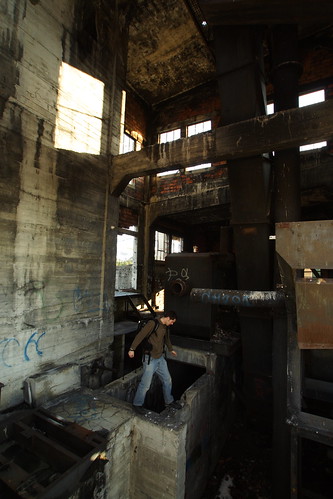


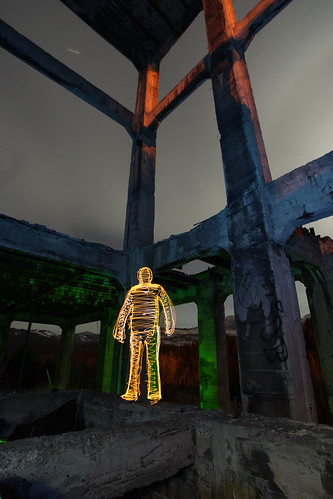
Saturday, July 4, 2009
Caution Radiation!
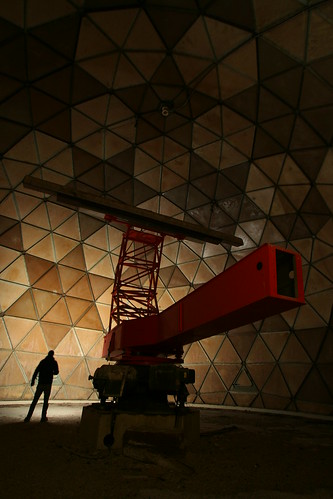
I was looking at the radar station at CYYC (Calgary International) one day while driving home from the airport and was intrigued by the structure. Looking online, I was curious to see what the inside of a primary radar station looked like. Some Google searches led me to a random site dedicated to the Pinetree Line, a series of military radar stations that were set up across North America to give early warning of a missile attack during the Cold War. The radar station is one of the only ones still standing and is, I believe, the most preserved one (mostly because it's truly in the middle of nowhere).
The drive was long and boring. Three hours across open prairies. When I first saw the massive structure on the horizon, I didn't realise it was still 30km away. haha. I drove up to the front gate and parked. The fences were guarded by razor wire, but the gate was quite plain and was bent up enough to allow me to squeeze through it.
Stepping in it for the first time, I noticed that it was already quite trashed on the lower level. I was already worried that the inside of the dome would look like crap from loads of graffiti. Luckily, there was nothing more than some smashed boards. The first floor gave me a startle as I came within close proximity to an owl. I soon noticed that there was absolutely nothing inside the room. Everything cool that likely used to be inside was stripped out. No mapping tables, no screens or even machines that go 'Bing!' were inside. I guess it makes sense because it was a military building.
The second floor was similar to the first; open, bare and kind of disappointing. I made my way of a crazy ladder which led through a foot of concrete flooring and into the radar dome. The inside of the dome was staggeringly huge. Every step I made was followed by a crazy echo from the dome walls. The radar was missing its dish, but was still really big. Again, not a whole lot of stuff inside the room, but it was still amazing to look at. The dish (or.. what's left of it) was mounted on a rotating base that you could actually move by hand. This proved handy for repositioning the radar during pictures.
I poked around during the day, took some photos and later went into the nearby town to have a quick meal and wait for it to get dark. The town's only restaurant looks like a copy of Corner Gas. A gas station-restaurant that served Chinese-Western food. They make a great burger, although the place was kind of odd because there were nearly a dozen cats wandering around outside the gas pumps (seriously).
Night came slowly and I returned to the radar station for some classic light-painting. After a few hours and many pictures, I left. I felt a great deal of accomplishment as I drove away. Not only did I know what the inside of a radar dome looked like. I was in one.
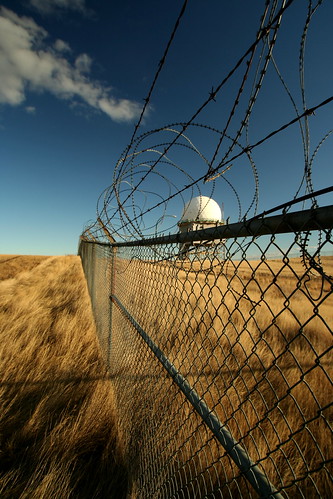
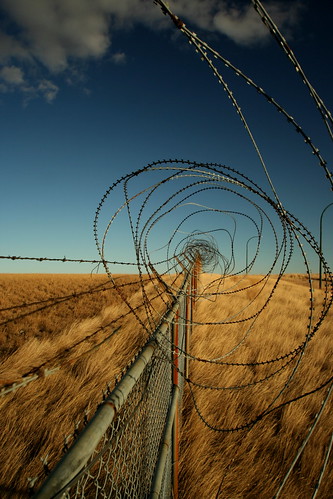
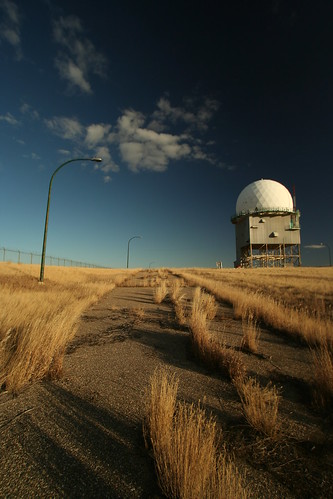
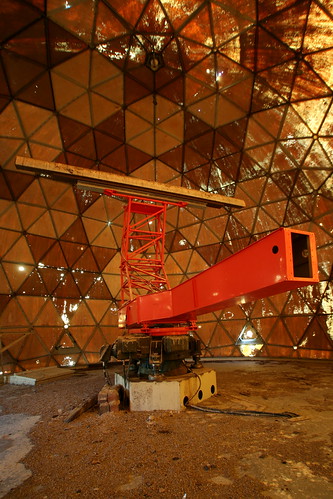
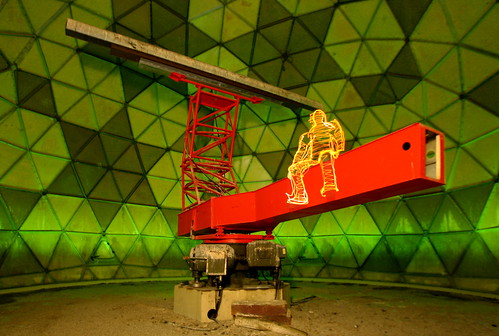
Labels:
Abandoned,
Cold War,
Defence,
Missile,
NORAD,
Pinetree Line,
Radar Station,
Urban Exploration
The Laing House

This place was first shown to me by some fellow students who knew I would love to see it. It was described by them as a huge, creepy place.
The hike out to the house was far longer that originally expected. Visible from the highway, it doesn't look like much, but the house is planted on the side of a steep hill and you have to walk through two valleys to get to it (which, surprisingly isn't noticed from the highway).
A good friend, and fellow explorer actually visited a lady who used to live there. She was very old, and described how, while she was very young, her father killed her pony and fed it to the family.
It sounds like the perfect creepy house for some sort of horror story, but I still stand strongly on the opinion that a place is only as creepy as you let your imagination make it.
I have since made several visits to it both at night and in the day. The only presence I felt there was pigeons. haha
Subscribe to:
Posts (Atom)

